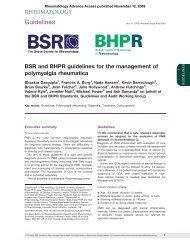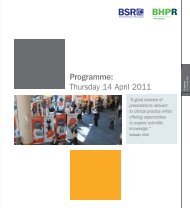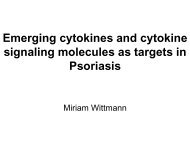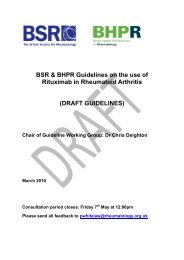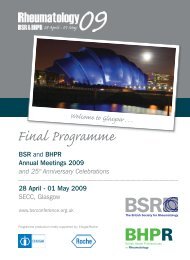Guidelines for the treatment of psoriatic arthritis with biologics
Guidelines for the treatment of psoriatic arthritis with biologics
Guidelines for the treatment of psoriatic arthritis with biologics
You also want an ePaper? Increase the reach of your titles
YUMPU automatically turns print PDFs into web optimized ePapers that Google loves.
Multiple open label studies and registry data have confirmed <strong>the</strong> potential benefits <strong>of</strong> “switching” anti‐TNF<br />
<strong>the</strong>rapies in patients <strong>with</strong> PsA. There are RCTs <strong>of</strong> sufficient quality to confirm this benefit. Studies <strong>of</strong> patients<br />
<strong>with</strong> PsA, taken from cohorts and registries <strong>of</strong> psoriasis and SpA patients have generally shown a lower<br />
response rate to second and subsequent anti‐TNF <strong>the</strong>rapies when compared to a first drug, but never<strong>the</strong>less<br />
have shown a significant response [84‐90]. Data from larger registries have shown that patients who switch<br />
drug due to adverse events have a higher likelihood <strong>of</strong> persistence <strong>with</strong> a second <strong>the</strong>rapy than those who<br />
switch due to loss <strong>of</strong> efficacy [86]. At present, <strong>the</strong>re is not enough systematic evidence to identify if switches<br />
between certain drugs show better efficacy than o<strong>the</strong>rs.<br />
Recommendations<br />
• In <strong>the</strong> case <strong>of</strong> failure <strong>of</strong> an anti‐TNF <strong>treatment</strong> ei<strong>the</strong>r due to inefficacy or adverse events, an<br />
alternative anti‐TNF <strong>the</strong>rapy should be considered, and response to <strong>treatment</strong> assessed as <strong>for</strong><br />
<strong>the</strong> first anti‐TNF agent. Consideration <strong>of</strong> <strong>the</strong> possible consequences on control <strong>of</strong> skin disease<br />
should be given, and in shared care <strong>with</strong> a Dermatologist when appropriate (Grade B).<br />
Consensus score 9.5<br />
ALTERNATIVE DOSING/ADMINISTRATION OF ANTI‐TNF THERAPIES<br />
There are few data investigating alternative doses or administration routes <strong>of</strong> anti‐TNF <strong>the</strong>rapies. The Swedish<br />
registry reported data on patients <strong>with</strong> PsA treated <strong>with</strong> infliximab at a dose <strong>of</strong> 3mg/kg every eight weeks. A<br />
higher proportion <strong>of</strong> patients <strong>with</strong> PsA required a dose escalation which is in keeping <strong>with</strong> <strong>the</strong> recommended<br />
<strong>treatment</strong> dose <strong>of</strong> 5mg/kg every eight weeks in <strong>the</strong> UK [25]. However in Cherouvim’s open label study, <strong>the</strong><br />
majority <strong>of</strong> patients <strong>with</strong> AS and PsA responded well to lower dose infliximab. Ten <strong>of</strong> <strong>the</strong> 13 PsA patients<br />
showed a significant response to <strong>the</strong>rapy, <strong>with</strong> one patient showing no response at all and two patients<br />
showing worsening <strong>of</strong> response after <strong>the</strong> initial loading regime [91]. Covelli also found a good response to low<br />
dose infliximab in resistant PsA patients but a relapse was seen in all patients once infliximab was <strong>with</strong>drawn<br />
[92].<br />
In 2006, a small open label study evaluated <strong>the</strong> use <strong>of</strong> high dose etanercept <strong>for</strong> 12 weeks followed by standard<br />
dose <strong>for</strong> a fur<strong>the</strong>r 12 weeks. This was tolerated well and <strong>the</strong> patients showed a good response in both <strong>arthritis</strong><br />
and skin psoriasis [93]. Following on from this, <strong>the</strong> PRESTA study compared differing doses <strong>of</strong> etanercept<br />
(50mg weekly vs 50mg twice weekly) in an RCT over a 12 week period. There was no significant difference in<br />
<strong>arthritis</strong> outcomes, but a higher PASI response was seen <strong>with</strong> <strong>the</strong> higher dose <strong>of</strong> etanercept [17]. The studies<br />
<strong>of</strong> golimumab in PsA used two alternative doses <strong>of</strong> golimumab, ei<strong>the</strong>r 50mg or 100mg every four weeks. The<br />
study was not powered to investigate <strong>the</strong> different doses and showed a significant improvement in <strong>psoriatic</strong><br />
disease <strong>with</strong> both doses when compared to placebo. There was a suggestion <strong>of</strong> a higher response in skin/nail<br />
disease <strong>with</strong> <strong>the</strong> 100mg dose [19].<br />
A number <strong>of</strong> small studies or case reports have investigated <strong>the</strong> use <strong>of</strong> intra‐articular anti‐TNF <strong>the</strong>rapy <strong>for</strong><br />
mono<strong>arthritis</strong>. Studies have evaluated <strong>the</strong> use <strong>of</strong> infliximab [94, 95], etanercept [96‐98] and adalimumab [98]<br />
given directly into inflamed joints. The majority <strong>of</strong> patients showed a good response although <strong>the</strong> injections<br />
were also <strong>of</strong>ten combined <strong>with</strong> IA steroid in addition to <strong>the</strong> anti‐TNF agent. Some patients showed a lasting<br />
benefit <strong>for</strong> a number <strong>of</strong> weeks or months, but <strong>the</strong> longer term outcome <strong>of</strong> <strong>the</strong>se patients has not been<br />
reported. Efficacy <strong>of</strong> intra‐articular TNF drugs has not been evaluated in a clinical trial.<br />
ALTERNATIVE BIOLOGICS IN TESTING/DEVELOPMENT<br />
15





